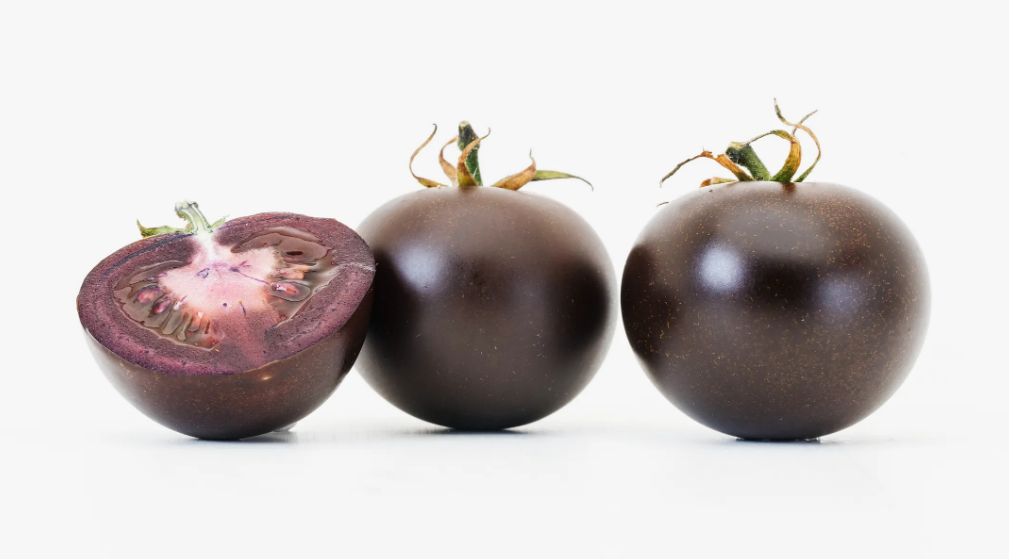
We’re coming up to the end of this year’s tomato season, and while it makes me sad, it also means we’re that much closer to next year’s tomato season! I’m hoping that will bring the debut of a new tomato that I just read about in Wired: a regally purple berry (yes, berry) that packs a major antioxidant punch.
The creators of this tomato genetically modified it with genes from a snapdragon, which boosts its colour and anthocyanin content — the same antioxidant found in blueberries and blackberries. Its gorgeous appearance marks a shift in GMO strategy: away from impressing farmers with yields and hardiness, and toward consumers trying to make healthier choices.
“Norfolk Plant Sciences, a company cofounded by [the purple tomato’s inventor, plant scientist Cathie] Martin, plans to roll out a purple cherry tomato in a handful of test markets in 2023. The biotech firm is also working on purple tomato juice, sun-dried tomatoes, and beefsteak tomatoes, and plans to sell seeds for backyard gardeners. ‘We hope people will eventually grow their own,’ says Martin. […]
While purple-skinned tomatoes have been developed through conventional breeding, they don’t accumulate high levels of anthocyanins in the flesh. There’s evidence from other researchers that these compounds may help prevent cancer, reduce inflammation, and protect against type 2 diabetes. And in a 2008 study, Martin and her team found that mice that were predisposed to developing cancer lived 30 percent longer on a diet supplemented with purple tomatoes than mice on a regular diet supplemented with normal red tomatoes. (Of course, animal studies don’t always translate to humans, and there are many lifestyle and genetic factors that may affect a person’s cancer risk.)”
The developers are hoping that the time of the “Frankentomato” has passed, and younger consumers who’ve seen the successful track record of GMOs in the food chain will be more willing to try a modified product, especially if health benefits are involved.
While the above-mentioned test markets will be in the U.S., I hope it goes well and Canada follows suit soon after. I’m intrigued by the flavour possibilities — tomato varieties can be so subtly different from one another. And what a spectacular Caprese salad or pizza sauce these jewel-toned beauties would make! I await the future of the tomato with glee — and will keep you updated.
Once upon a time, we had the luxury of never sparing a thought about our planet’s ability to support us. But things have been getting increasingly complicated as we uncover the unexpected fallout of our choices, making stewardship of our natural environment a tricky thing indeed.
The venerable Monterey Bay Aquarium has been doing some of this fancy footwork in the whale-saving department and taking an unexpected detour through seafood lovers’ plates. They’ve red-listed Atlantic lobster – that is, given it their lowest rating, “avoid,” in their Seafood Watch sustainability guide – in an effort to drive down demand for the crustacean. Commercial lobster fishing involves long vertical ropes, stretching from the trap on the sea floor to buoys on the surface, dotted throughout the migration route of the critically endangered North Atlantic right whale. The whales can get tangled in the fishing gear, which prevents them from swimming and feeding, and potentially causes their deaths.
demand for the crustacean. Commercial lobster fishing involves long vertical ropes, stretching from the trap on the sea floor to buoys on the surface, dotted throughout the migration route of the critically endangered North Atlantic right whale. The whales can get tangled in the fishing gear, which prevents them from swimming and feeding, and potentially causes their deaths.
“Other fisheries added to the red list include all fishing for Jonah crab, and other trap, pot, and gillnet fisheries. Gillnets are a wall of netting that hangs vertically in the water, while traps and pots also have vertical lines from the surface.
Oceana, a conservation pressure group, urged the US and Canadian governments to implement stronger measures to protect North Atlantic right whales. ‘It’s unfortunate that the government’s failure to update the safeguards to protect North Atlantic right whales is having such serious consequences on these [lobster] fisheries,’ said Gib Brogan, Oceana’s campaign director. […]
Strong fishing regulations were needed to avoid interactions and minimise the effects of interactions, he said. To give the species a fighting chance, the National Marine Fisheries Service (also known as NOAA Fisheries) should reduce the number of vertical lines and gillnets in the water and move to whale-safe fishing equipment, such as ropeless gear, Brogan said.
‘Ordering lobster or crab should not mean jeopardising the future of critically endangered North Atlantic right whales,’ he said.”
With fewer than 340 right whales in existence, it’s incredibly important to preserve as many individuals as possible. Doing so by informing lobster fans of the consequences of their favourite nosh is cleverly effective. Love of the delicacy may even drive the reforms right whales need if lobster enthusiasts band together. I’d be happy to sacrifice a few celebratory meals if it means taking responsibility for ourselves and caring for these gentle giants of the seas.

Now that it’s September, I’m resigned to the fact that fall is around the corner. One small silver lining is that the more the weather cools, the more comfort food we can enjoy – including chocolate! But there are some innovations happening in the confection sphere that will make chocolate even more enjoyable; not just for our tastebuds, but for our consciences too.
Several startups are working on “non-cocoa chocolate;” that it, lab grown sweets sourced from cell cultures, that are indistinguishable from the real thing in taste and texture. By decoupling the existence of chocolate from the cocoa bean, these companies hope to make tasty treats that are more resilient in the face of climate change and don’t also represent deforestation and child labour. But the situation is complicated, and also needs to take into account the economic impacts of small-scale farmers who supply many of the world’s cocoa beans.
“‘People have an emotional connection to chocolate that they don’t have to cornflakes,’ says Clay Gordon, author of Discover Chocolate: The Ultimate Guide to Buying, Tasting, and Enjoying Fine Chocolate, and a renowned cocoa industry observer and consultant. […]
Cocoa is especially vulnerable because it is predominantly grown by smallholder farmers. He says these farmers have no collective bargaining leverage and fair trade isn’t working to force major global companies to pay fair prices.
Gordon sees a market for lab-grown chocolate similar to the growing market for substitute plant-based meat products. It is not competitive in the short term and hence will not have an immediate impact on the cocoa industry which many in west Africa depend on. However, in the event of an unprecedented global climate event or ‘potential disruptors,’ the rise in the use of lab-grown chocolate and other food products could be impactful.”
It seems there are lots of factors these days that are causing this manufacturing pivot. It makes sense that developers are trying to get ahead of any one of these potential market enders. I know I’d be a lot happier with a treat that made the world happier too; from the farmers to the harvesters, to the general environment. If that chocolatey goodness flows from a place of responsibility and kindness, it’ll taste all the sweeter.